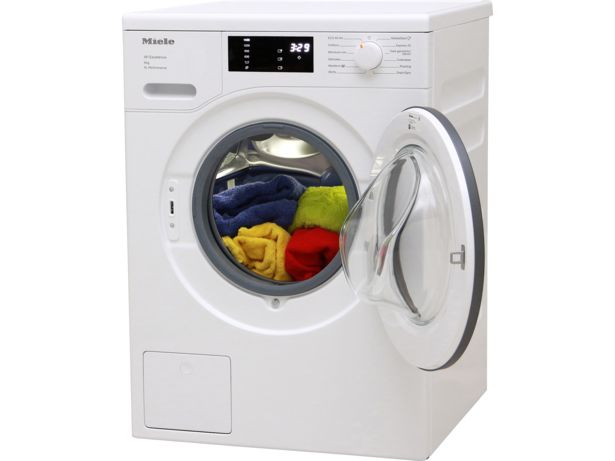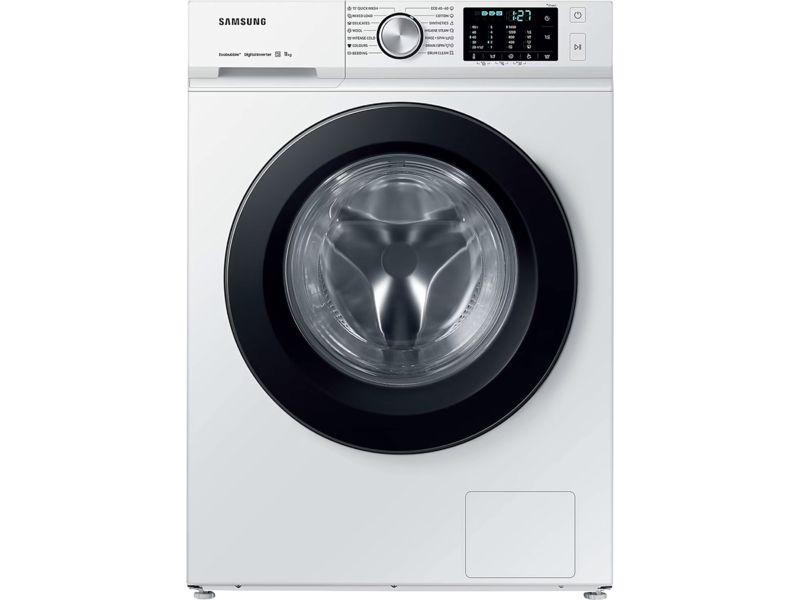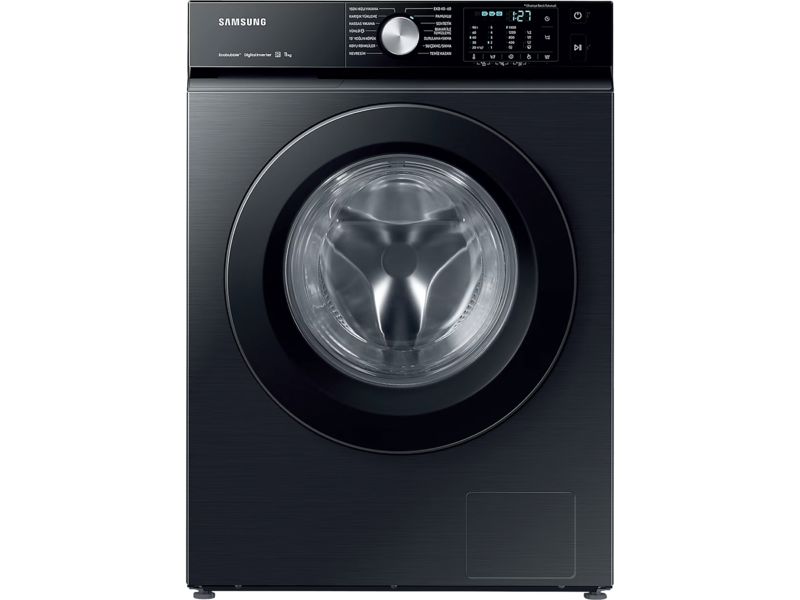Useful washing machine programs

Here, we take you through some of the most common washing machine programs, and those that can be a real added benefit worth looking out for if you're shopping for a new model.
Also read our guide: How to wash clothes
Synthetics or cottons
Many washing machines have separate programs for cottons and synthetics, sometimes alongside different temperature settings. Cottons programs are often hotter, while synthetics programs run at lower temperatures, 40°C or below, and spin less frequently.
Synthetic programs, also called 'easy care', are designed for non-cotton garments, such as clothes made from polyester and viscose, that need a slightly more delicate wash.
Synthetics programs wash at lower temperatures and spin less frequently
Most machines will have a cottons program, but not all will have a synthetics one. If you need to wash a lot of delicate clothes, it's worth keeping a lookout for this, although you'll need to check the clothes label first.
However, there are other similar programs - delicates, handwash and wool - that you could look for instead, depending on what type of clothes you wash most. Keep in mind that the capacity is different for some of these programs, so if you're keen to buy a specific capacity machine, check this first.
When we test washing machines, we test the 40°C cottons and synthetic cycles, and have found big differences between them, even on the same machine. You can check how well each machine does on these different programs in our washing machines reviews.
Wool/delicate/handwash programs
These are typically low temperature programs that have minimum drum rotation during the wash to keep the garments from being damaged, similar to synthetics programs.
As with the synthetics wash, if you have a lot of delicate clothes, especially wool and silk, then these could be useful. However, make sure you read the care label first as some clothes recommend that you never wash in a machine.
Sports programs
These are for washing microfiber sports clothing, designed to remove sweat marks and odours by having a longer wash cycle, but washing at a lower temperature, so as not to damage the fabric. Some machines also have a special program to allow you to wash your trainers.
This could be useful if you need to wash lots of sportswear, but it's not something we've ever tested. However, a great washing machine should be able to remove a range of tough stains in a normal wash, no matter what the item.
You can see which washing machines have earned our Best Buy recommendation, meaning they remove stains with ease, will rinse away detergent and dry your clothes evenly by visiting our best washing machines page.
Quick wash settings
Quick wash programs are very popular and an option on many machines. As you might expect, these programs allow you to wash your clothes in a shorter amount of time than a normal program, for some it might be as little as 15 minutes.
They're therefore great if you need to wash something quickly, such as a dirty school uniform needed for the next morning. Some machines come with more than one quick wash option, too.
But be aware that the quickest washes may only let you wash 1.5kg of clothes at once, which is equivalent to two pairs of jeans. Some washing machines have a full-load quick wash option, allowing you to fill the drum, but these are usually only for lightly soiled clothes.
Temperature programs
All washing machines have temperature settings so that you can wash your clothes in hotter water, maybe to remove more stains, or cooler water to save money.
Some machines will give you straightforward 30°C, 40°C, 60°C etc options, while with others temperature settings are combined with other options, such as 60°C cottons or 30°C synthetics.
As temperature settings are on all washing machines, it's really a case of thinking about how many options you want and in which format.
Our tests have found that washing at 30°C can save you up to 38% on running costs compared with washing at 40°C and will still remove everyday stains. And washing at 20°C uses 62% less energy than washing at 40°C.
To help you decide, take a look at our washing machine temperature guide for full information on washing at different temperatures, from 20°C to 90°C.
We've found that washing at 20°C can save you up to 62% on running costs
Time-remaining display and automatic detection
Some washing machines have a display that counts down until your washing is ready, so you know how much time is left.
More advanced washing machines will detect how much is in the drum by weighing it and then provide an estimate on how long it will take to clean.
A time-delay setting can be really useful for making sure you're around when the washing is finished so you can put it straight out to dry or in the tumble dryer.
The automatic weighing option means a machine will only run for the time needed to clean that amount of laundry, which could save on energy, but this can be an expensive feature.
Delay start/End time
A delay start means you can choose when you want the washing machine to start washing your clothes, say a couple of hours before you get home. Alternatively, some machines have ‘end time’ functions, which allow you to choose when the program finishes, as opposed to when it starts.
Some delay time programs are limited to nine, six or just three hours
This could be a really useful feature, especially if you don't want your washing to be sat in your machine for too long once it's run the cycle. However, although some machines are fairly flexible and will let you delay the start by any number of hours, up to 24, others are more limited and might make you choose from a three, six or nine-hour delay start, so check before you buy.
Also, although these are quite common features, they're not on all machines, so check before you buy if it's something you're interested in.
Child locks
There are two types of child locks on washing machines. The most common is a function that can disengage all the controls on the panel, similar to the way you might lock your mobile phone. This means programs and settings can't be tampered with by the little ones when your back is turned.
The second, less common child lock, which is also called a door safety lock, is a device that will stop the door from being closed. This means kids can't lock items in the drum that shouldn't be there.
If you have kids, these can be useful features. You can read our washing machines reviews to find the models with a door safety lock or panel safety lock.
Pre-ironing/easy iron/anti crease
An iron program should help to prevent creases from forming in clothes, typically by lowering the spin speed or shortening the spin cycle. Some washing machines will have a setting that alters other programs, as opposed to being a standalone program. If you do a lot of ironing, one of these programs could be worth looking for.
Baby care
This is usually a quite intensive wash program at a high temperature, followed by several rinses to try and make sure as much detergent is removed from the clothes as possible.
Another alternative is just manually setting the temperature yourself - we have a guide to washing machine temperatures to understand which program would be best to wash at. In addition, we test each machine to check whether it will leave traces of detergent on your laundry - we've seen some leave visible traces.
Hygiene/anti-allergy
A hygiene cycle is designed to remove allergens from laundry, typically by keeping the water temperature high or using steam, if your washing machine has a steam function. Our research shows you can't just rely on the cottons 60°C program to rid clothes of allergens and bacteria, though - see our guide above on washing machine temperatures.
Eco
As the name suggests, this program should save you energy. We don't test washing machines on this setting, but we do measure the amount of energy and water each machine uses on the normal washing programs, so we can tell you which ones will cost a lot to run, and which will be cheaper.
We've found washing machines across a range of running costs, so visit our washing machine reviews to find the best for you.



